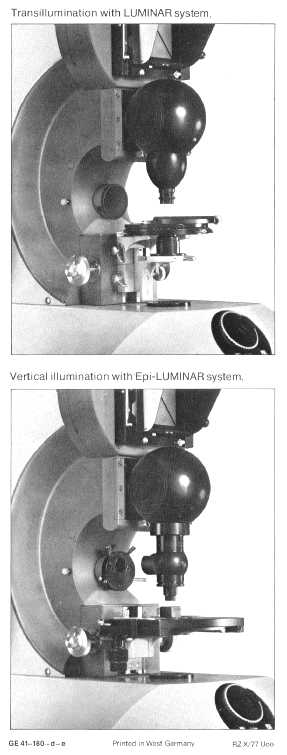Photomacrography with the Ultraphot
 |
Luminar macro-anastigmats are used without eyepieces and are justly renowned for their resolving power and flatness of field. They are available in 16, 25 40, 63 and 100mm focal lengths, the first four having RMS objective threads, the last bearing an M44 X 0.75mm screw and/or an annular dovetail for fitting directly onto a Luminar Head. In addition, there is the remarkable ‘zoom’ Luminar which yields magnifications of 2.5 – 5 on the microscope’s 5 X 4 camera. This is also fitted with the Zeiss 43.5mm annular dovetail. The 16, 25 and 40mm lenses are attached to the Luminar Head by the ‘egg-cup’ adapter shown in the upper photograph. The 63mm needs a different one. For transillumination, the 16 – 100mm Luminars are used in combination with matching ‘spectacle lens’ condensers and a standard stage, but the ‘zoom’ lens needs the massive Macro Stage with its built-in condenser. Special epi-Luminars are available for the photography of highly polished materials by epi-brightfield illumination. Available in focal lengths of 20, 25 and 40mm., they have a 40 X 0.75mm mount, and lack iris diaphragms. The lower photograph shows a 40mm lens attached to the bottom of the ‘Survey Illuminator’ provided for these objectives. Standard 63 and 100mm Luminars are employed where lower magnifications are needed, each with its own type of illuminator mounted underneath the lens. The tubehead of the Ultraphot is replaced by a Luminar Head for the purpose of photomacrography or when Luminars are to be employed, in combination with the190mm rear projection screen, for very low power observation. It is a more or less spherical structure that contains the mirrors necessary to reflect the image into the interior of the microscope. |
| Go to Front Page |